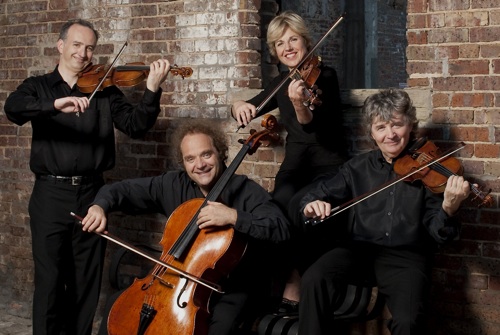After a summer of recuperation and preparation, San Francisco Performances is open for business again. Popular jazz vocalist Paula West, backed by the George Mesterhazy Quartet, unveiled her new material for their opening event on Friday, October 8, kicking off SF Performances’ jazz series before setting off for engagements in New York.
Hungarian wit propels Haydn
The following night saw the Grammy-award winning Takács Quartet at Herbst Theater in a program of later quartets by Haydn, Bartók and Beethoven. The three works displayed each composer’s creative decisions in full bloom, each a master of their own game. The Takács quartet performed with energy, wit and, at times, truth, as the integrity of their approach matched the core of the work.
Haydn wrote his G Minor quartet, Opus 74, for British audiences after his retirement from the court of Prince Esterhazy. Meant to air in a larger theater, the writing is bold and has more contrasts than his intimate quartets. Lilting triplets ran from a gentle canter to full gallop, earning this work the sobriquet of “The Rider.”
The Takács gave it a lovely sense of timing, accentuating Haydn’s humor. In the Largo movement they supplied slow leans and dense blends. One could feel the passion and restraint, and over it a gentle melancholy, almost regret. To pull this off the Takács needed masterly exactitude, over and beyond their intelligent reading and excellent blend. If there is a place, in this hectic age, for elegant and charming, then this was it, with the Takács playing Haydn.
…and Bartók done to a turn
But this was just salad with the main course still to come. Hungarian composer Béla Bartók wrote the fourth of his six string quartets in 1928, a work of strict formal logic with an astonishing depth of feeling. Bartók was at his most experimental here, with extended techniques, dissonance, and modal and whole tone scales.
But his striking use of rhythm was one that fit well with Takács. Founded in 1975 in Budapest—and two of the members remain from those days—this quartet explores the music of Hungary, and the forward inflection of its rhythms and speech.
The powerful opening had staggered entrances, building a tone cluster of notes for an uncomfortably direct venture, a modernist use of sonata form. Slides and whips displayed the virtuosity of first violinist Edward Dusinberre, while violinist and founding m
ember Károly Schranz gave us rich hues and Hungarian bite.
Sudden unison chords cut across the rhythms, as menacing as Shostakovich’s “knock on the door” (the terrifying Quartet No. 8 in C Minor—see Aug. 25 Piedmont Post). Soft upward whole tone scales were sharply cut across. Then in Prestissimo, con sordino mutes came out to turn the light bowing into ghostly traceries. Slippery rumbles gave way to a soft hive of unrest.
Newest member Geraldine Walther, former first viola of the SF Symphony, muted her viola from sonorous to weepy, a chilling center to their sound.
The Lento center movement built slow chord clusters, descending whole tones of the upper strings, over which cellist András Fejér sang wistful high passages. Fejér, another original member, slid down to meaty lows, then reprised the theme, and each of the others followed, a brief spotlight over the thin tissue.
The difficult fourth movement, entirely in pizzicato, was a perky—albeit creepy—play on the second movement theme, creating an arch-like structure that anchored in the final Allegro, where they repeated the slashing chords of the opening. Fierce and uncompromising, these players offered a vision that felt rooted and genuine.
And after the main course? Soup, unfortunately, as intonation problems and mistimed entrances turned Beethoven’s String Quartet in E-flat Major a little mushy. After two energetic triumphs it would be surprising if they were able to give it the reading it deserved. And that quartet in particular is famously fussy: its opening chords require both big sound and exacting timing, two forces that are often at odds.

SF Performances held their season-opener Gala on Friday, Oct. 15 at the Mark Hopkins Hotel, featuring composer Jake Heggie, of the opera Dead Man Walking fame, and soprano Talise Trevigne.
The rest of the season is full of surprises, with Vivaldi’s Four Seasons paired with a modern conception of that work by minimalist Philip Glass on Tuesday, Nov. 2 at 8:00 at Herbst Theatre. The startling and powerful Sankai Juku dance troupe appears at Yerba Buena Center for the Arts Nov. 11-13. Tickets and information are available at 415-677-0326, and at www.performances.org.
—Adam Broner
Originally published in the Piedmont Post. Photo of Takács Quartet, first violin Edward Dusinberre (left), cellist András Fejér, violist Geraldine Walther and violin Károly Schranz; photo by Ellen Appel.
